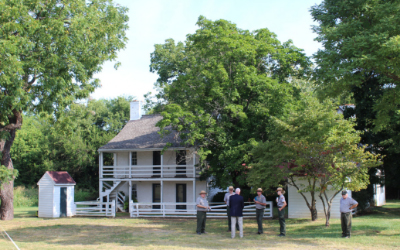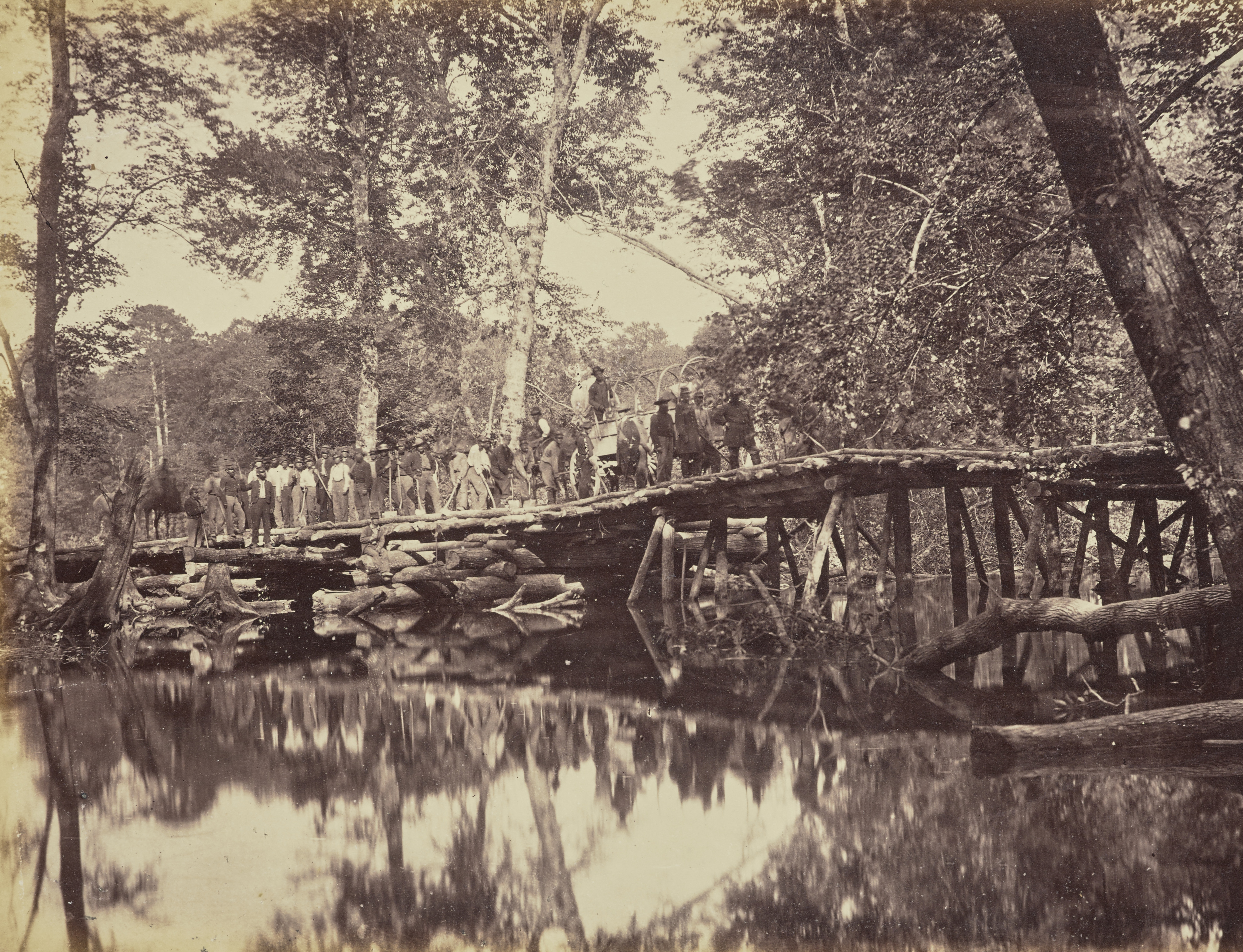“Sketch Book of the War” considered one of the 19th century’s most important photographic works
The National Gallery of Art in Washington, D.C., announced in August that it had acquired a copy of Alexander Gardner’s Photographic Sketch Book of the War, published in 1866 and considered one of the most important photographic works of the American Civil War and the 19th century. The acquisition significantly expands the Gallery’s existing collection of American Civil War photography
Gardner’s Sketch Book spans the entire war, with one hundred albumen prints organized chronologically and “intentionally composed to elicit an emotional response from the viewer,” the National Gallery of Art announced. “Among the subjects featured in the photographs are the engineering accomplishments necessary to prepare for battle: pontoon bridges, wooden railroad trestles, fortifications and batteries. Other photographs depict Army headquarters and posed scenes of camp life, while a handful of images show the destruction wrought on cities and the dead on the field at Gettysburg.”
The Sketch Book was a costly project at the time and only two hundred were produced. When it appears at auction in fine condition, it sells in the $100,000 to $200,000 range.
Major Renovations to Wilson’s Creek National Battlefield announced
Wilson’s Creek National Battlefield will undergo a $4.5 million makeover that will allow it to more fully display what is widely considered to be one of the finest publicly held museum collections representing the Trans-Mississippi Theater of the Civil War.
Currently, most of the park’s more than 81,000 artifacts are in storage, but that will change with the addition of 1,873 square feet of exhibit space and updates to interactive and “virtual displays.” The renovation also calls for upgrades to the visitor center’s heating and air conditioning systems for both protection of artifacts and visitor comfort. The park’s attracts 200,000 visitors a year.
Funding for the $4.5 project is provided by the National Park Foundation; the National Park Service; the Wilson’s Creek National Battlefield Foundation; individual donors; corporate partners, including Bass Pro Shops and Arvest Bank; and the U.S. Congress.
The announcement that full funding had been raised was made August 10 to commemorate the anniversary of the Battle of Wilson’s Creek, which occurred on the same day in 1861. On that day more than 17,000 soldiers in southeastern Missouri fought in the first major Civil War battle west of the Mississippi River.
Renovations will begin later this year and will require the visitor center to be closed for about nine months.
Administered by the National Park Service, Wilson’s Creek National Battlefield is considered one of the best-preserved battlefields in the National Park System. The battlefield is located near Republic, Missouri, about 10 miles southwest of Springfield, at the intersection of Highway ZZ and Farm Road 182.
Key John Brown’s Raid Site Donated to National Park Service

The American Battlefield Trust in August formally transferred the 13-acre Allstadt’s Corner property in Harpers Ferry, Va., to the Harpers Ferry National Historical Park. The action prevents development from encroaching on a highly visible segment of the battlefield and marks the long-term preservation partnership between the Trust and Harpers Ferry National Historical Park.
The property, purchased by the Trust in 2014, includes the still-standing “ordinary,” or tavern, that played an important role in John Brown’s 1859 raid on the federal arsenal at Harpers Ferry, while the surrounding farm saw action during the 1862 Battle of Harpers Ferry.
To date, the American Battlefield Trust has protected 542 acres at Harpers Ferry, much of it along Schoolhouse Ridge. Of those 542 acres, 342 acres have become part of the national park and the rest serve as viewsheds protected through a conservation easement.
Solar farm withdraws application in Culpeper County, Virginia
The company that had proposed building more than 380,000 solar panels on 1,600 historically sensitive acres in southern Culpeper County, Va., formally withdrew their application in August.
It is unclear if the proposal will be resubmitted. The move came just three weeks after California-based BayWa R.E.’s Cricket Solar LLC had submitted a revised plan to the application first filed in December 2018.
BayWa’s attorney Ann Neil Cosby said the withdrawal was to “ensure that any project proposed represents Cricket’s best effort to address community concerns.”
The local group Citizens for Responsible Solar had called for the project to be, at minimum, delayed because of proximity to the Rapidan River and the historic district of Raccoon Ford, including a number of Civil War battlefields in the vicinity. The group circulated an anti-solar petition, conducted a poll of residents and recruited American Civil War epics filmmaker Ron Maxwell (Gods and Generals, Gettysburg, and Copperhead) to join the effort to stop or delay the project.
Clark B. Hall of Citizens for Responsible Solar told The Washington Post that Culpeper County was “the most fought-over, the most camped-upon, the most contested county in the Civil War,” and that he was certain there are dead soldiers scattered unburied across the land.
“As a result of the Civil War, a greater good emerged, and we commemorate that on battlefields we save, not that we put solar panels on,” Hall said. “It’s callous to put a solar panel field where men fought and died.”
720,000 bottle caps being collected to illustrate war’s death toll
 Even for those who’ve thoroughly studied the Civil War, it’s difficult to conceptualize the sheer number of casualties. One middle-school teacher—the 2016 recipient of American Battlefield Trust’s Teacher of the Year award—has a project that just might illuminate the depth of the losses.
Even for those who’ve thoroughly studied the Civil War, it’s difficult to conceptualize the sheer number of casualties. One middle-school teacher—the 2016 recipient of American Battlefield Trust’s Teacher of the Year award—has a project that just might illuminate the depth of the losses.
Phil Caskey, a teacher at Westwood Middle School in Westover, W. Va., is collecting bottle caps—ultimately 720,000 in all—to illustrate the magnitude of Civil War deaths. As of mid-September, he has collected 500,000.
“I wanted to do a quantification study to see and to kind of show our students and our community what the casualties and the cost of war actually look like.” Caskey told WHSV-TV3 in Harrisonburg, Va. “So, if you had 720,000, what does that number actually look like? 719,000 is just as important as 720,000. And by personalizing it and showing this, it hopefully will be a real (eye) opener…”
Caskey says he has received bottle caps from Alabama, Maine and Wisconsin. Anyone wishing to contribute bottle caps can call the school at 304-291-9300 for details.
On the beach and in a tree—Civil War ordnance discovered
Aaron Lattin and Alba Ospina knew the seashell hunting would be good after Hurricane Dorian passed through the Folly Beach, S.C., area. In addition to some nice shells, though, they found two Civil-War-era cannonballs—an eight-inch cannonball and a smaller three-inch shell.
“I wanted to get a metal detector, especially after the hurricane and see if there’s anything, any history or artifacts that kind of washed up on the shore. At first we just thought it was a rock,” Lattin told WLTX-19 in Columbia. “The more we got to looking we realized it was more than a rock.”
The couple notified authorities immediately, and the Charleston County Sheriff’s Office and U.S. Air Force explosive ordnance disposal experts deemed the artifacts safe after inspection.
This wasn’t the first time Civil War ordnance has washed up on Folly Beach: 16 cannonballs washed up in the same area after Hurricane Michael in 2016. Perhaps it’s not surprising as Folly Beach Island was occupied by as many as 13,000 Union troops in 1863.
And in what is an odder location, a Civil War cannonball was found lodged in a tree in the Kansas City area.
Jeff Eastham was chopping up the old and diseased tree he had felled at the historic Overfelt-Johnston house in Independence when the cannonball rolled out.
“It’s pretty cool. I mean, I’m not a history buff, but I think it’s cool we’re standing on sacred ground so to speak; just, you know, the war was fought here,” he told KMBC-News 9.
The Overfelt-Johnston house was used as a hospital during both first and second Battles of Independence, in 1862 and 1864. Another cannonball was found on the property in 1980 when the house was being restored, said owner Randall Pratt. He indicated this newest cannonball will be displayed at the home. The first is displayed atthe Jackson County Historical Museum.
Inaugural Youth Leadership Team begins year of service to historic preservation
After a three-day trip to Washington, D.C., for orientation and training, the American Battlefield Trust’s inaugural Youth Leadership Team returned home to begin year-long programs of preservation and interpretation projects in their communities.
Participants were chosen in a competitive process by the Trust. The high school students will return to Washington in late September to meet with their elected officials as part of the Trust’s first Youth Lobby Day.
Among the initiatives being undertaken by Youth Leadership Team members are organizing living history events, raising funds toward land acquisition and establishing clean-up gatherings, as well as more 21st-century offerings like a podcast series. During the Trust’s 2020 Annual Conference next May in Chantilly, Va., they will present their findings and results.
“By supporting this group of emerging leaders, we hope to create a ripple effect for battlefield preservation, visitation and history education in our nation,” said Trust president James Lighthizer. “They are the face of battlefield preservation for a new generation, empowering other young people to create change within their own schools and communities.”
The full roster of the 2019 Youth Leadership Team includes: Taylor Bishop, 15, of Greensburg, Ky.; Olivia Brinkman, 17, of Patchogue, N.Y.; Makayla Decker, 16, of Dillsburg, Pa.; Jessica Grajeda, 17, of Goodyear, Ariz.; Owen Lanier, 15, of Gloucester, Va.; Scott Lee, 15, of Los Angeles, Calif.; John Mugabe, 16, of Rock Hill, S.C.; Sarah Schwartz, 16, of Fort Myers, Fla.; Hays Turner of Middleburg, Va.; and Karalyn Viszoki, 16, of Monroe Township, N.J.
In Memoriam: Mike McAfee

Mike McAfee , a highly respected expert in American’s military history and photography, and curator of history at the West Point Museum for more than 48 years, died in August. Mike also served on the board of sister publication Civil War Times and was widely regarded as a leading historian on American military uniforms. He was 76.





